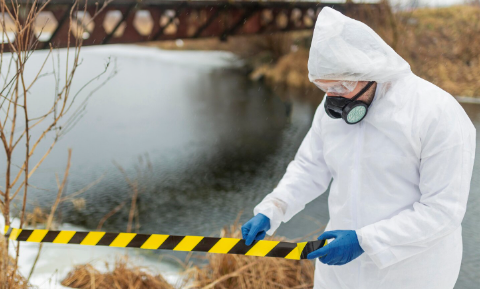Asbestlint: Dangers, Identification, and Safe Removal Guide

Many older buildings and industrial sites still contain remnants of hazardous materials from past construction practices. One of the most dangerous substances among them is asbestlint, a form of loose fibrous asbestos residue that can easily become airborne. Because of its microscopic fibers, asbestlint poses serious health risks when inhaled, including severe respiratory conditions and cancer. Despite the fact that asbestos has been banned or heavily regulated in many countries, asbestlint can still be found in older insulation materials, machinery, or hidden in attics and basements. Understanding what asbestlint is, how to identify it, and how to handle it safely is crucial to protecting your health and complying with safety regulations. This article provides an in-depth look into asbestlint hazards, detection methods, and removal procedures to keep you and your environment safe.
⚠️ What is Asbestlint?
Asbestlint refers to the loose, fibrous remains of asbestos that accumulate during manufacturing, installation, or deterioration of asbestos-containing products. Unlike solid asbestos boards or tiles, asbestlint is fluffy and light, making it extremely easy to become airborne and inhaled. It was commonly found in older textile insulation, lagging on pipes, and protective linings in industrial facilities. Over time, vibration, wear, or renovation work can release asbestlint particles into the surrounding air, where they can linger and pose a serious threat. Because of its loose structure, asbestlint is considered more dangerous than bonded asbestos materials since it releases fibers more readily.
🔬 Health Risks of Exposure to Asbestlint
Exposure to airborne asbestlint fibers is extremely hazardous to human health. When inhaled, these sharp microscopic fibers lodge in the lungs and stay there permanently, causing inflammation and scarring. Long-term exposure is known to lead to serious diseases such as:
-
Asbestosis – a chronic lung disease causing scarring and breathing difficulties
-
Lung cancer – significantly more common among people exposed to asbestos
-
Mesothelioma – a rare and aggressive cancer affecting the lining of the lungs or abdomen
Even minimal exposure to asbestlint over time can be enough to cause these life-threatening illnesses, and symptoms often appear decades later. This delayed onset is why strict safety precautions are essential during any contact with materials suspected to contain asbestlint.
🕵️ How to Identify Asbestlint
Identifying asbestlint can be challenging because it looks similar to ordinary insulation fluff or dust. However, some signs can raise suspicion:
-
Found in older industrial buildings or homes built before the 1980s
-
Resembles loose, fluffy white, gray, or brown fibrous material
-
Often located around pipes, boilers, or in wall cavities and attics
-
May be found near old machinery or within old protective clothing
Because visual identification is unreliable, the safest approach is to hire a certified asbestos inspector to collect and analyze samples. Professional testing can confirm the presence of asbestos fibers and prevent accidental exposure during inspection.
🧯 Safe Removal and Disposal of Asbestlint
Removing asbestlint must be done with extreme care and only by licensed asbestos abatement professionals. Attempting to clean or vacuum it yourself can release massive amounts of fibers into the air. Proper removal involves:
-
Sealing off the contaminated area with plastic sheeting
-
Using negative air pressure systems to prevent fiber escape
-
Wearing protective clothing and respirators
-
Wetting down materials to prevent dust release
-
Double-bagging waste in labeled asbestos disposal bags
-
Transporting and disposing of the waste at approved hazardous waste sites
These steps are strictly regulated by health and safety authorities to prevent contamination and exposure. Never disturb suspected asbestlint yourself — always call a professional.
⚙️ Regulations and Legal Responsibilities
Handling asbestlint is regulated under strict environmental and occupational safety laws. Property owners, landlords, and contractors are legally obligated to ensure safe handling and removal. Failure to comply can result in heavy fines, legal liability, and health claims. Regulations often require:
-
Asbestos surveys before renovation or demolition
-
Licensed contractors for removal
-
Notification of government safety agencies before work begins
-
Documentation of proper waste transport and disposal
Knowing and following these laws is critical for protecting public health and avoiding legal consequences.
📝 Conclusion
Asbestlint is one of the most dangerous legacy materials still present in older buildings and industrial sites. Its loose, fibrous structure makes it highly likely to become airborne and inhaled, posing serious and often deadly health risks. Recognizing its presence, avoiding disturbance, and using certified professionals for removal are essential steps to protect yourself, your workers, and your environment. Never underestimate the risks associated with asbestlint — proper handling can literally save lives. Prioritize safety, follow regulations, and treat any suspicious material with the utmost caution.
❓ FAQ About Asbestlint
Q1: What is asbestlint made of?
A: Asbestlint consists of loose asbestos fibers, usually remnants from older insulation or industrial materials that have deteriorated or been disturbed.
Q2: Is asbestlint more dangerous than solid asbestos products?
A: Yes. Because it is loose and fluffy, asbestlint releases fibers more easily into the air, making it more hazardous to inhale.
Q3: Can I remove asbestlint myself?
A: No. Removing asbestlint without professional equipment can spread fibers and increase exposure risk. Always hire licensed asbestos removal experts.
Q4: How can I tell if my building has asbestlint?
A: Only a certified asbestos inspection and lab test can confirm its presence. Visual inspection is not reliable.
Q5: What should I do if I find suspected asbestlint?
A: Avoid disturbing the area, prevent others from entering, and contact a professional asbestos abatement company for safe removal.